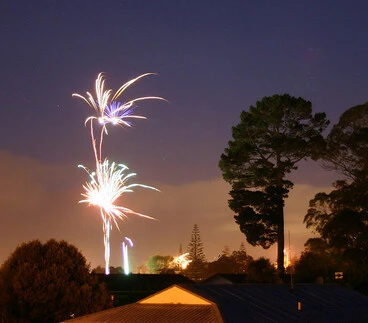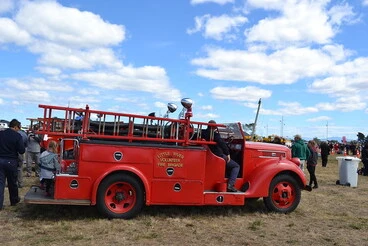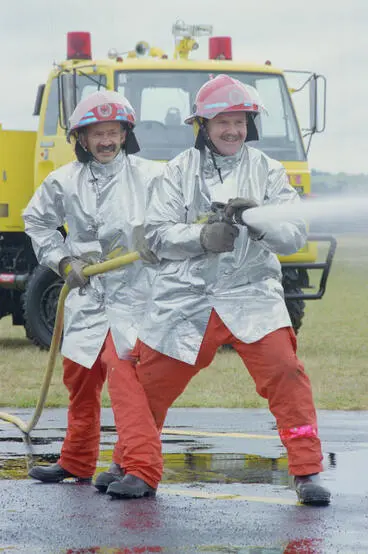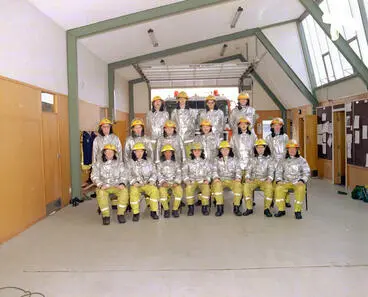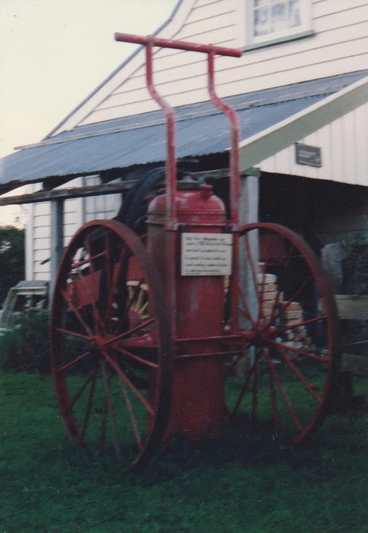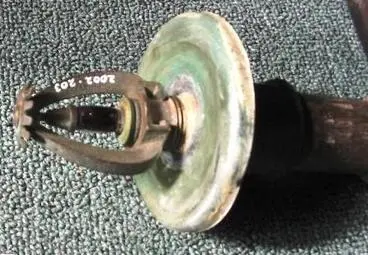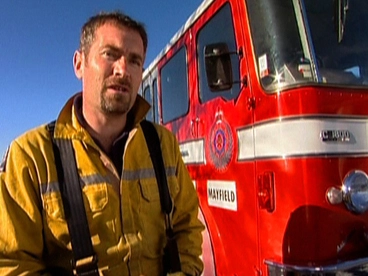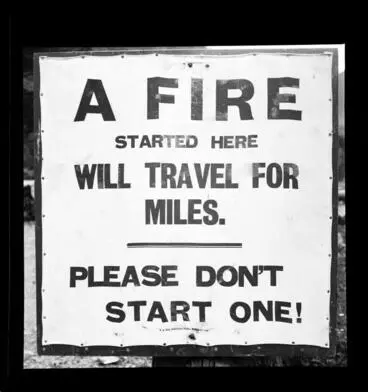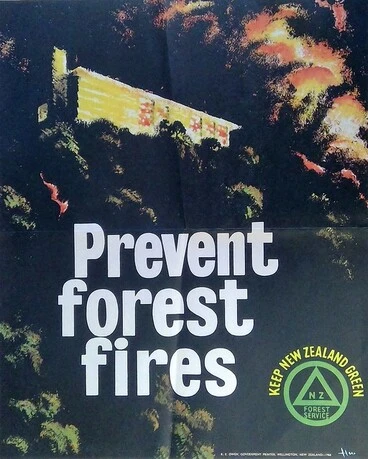Fire Safety
A DigitalNZ Story by National Library Services to Schools
This story covers how fires start, how to keep safe from fires at home and the people and tools that keep us safe such as firefighters, smoke alarms, fire extinguishers and sprinkler systems.
BACKGROUND
Fire can be dangerous but it has many uses. So it is important to know more about fire so that we can use it and still be stay safe around it.
There are many myths and legends about how fire came to earth. The most famous one we are familiar with in Aotearoa New Zealand is How Māui brought fire to the world.
Many scientists believe that Early Stone Age people used fire to cook, keep warm, and protect themselves from wild animals.
This story on fire safety contains the following:
- How does a fire start?
- Uses of fire
- Dangerous fires
- Fire safety
- Fire safety at home
- Fire escape plan
- Safety with fireworks
- Keeping us safe
- Fire and Emergency New Zealand
- Firefighters
- Smoke alarms
- Fire extinguishers
- Fire sprinkler systems
- Quick facts
- Glossary
- Bibliography
- Supporting resources
- Teaching and learning resrouces
- A gallery of posters on fire safety and prevention
Silverstream Volunteer Fire Brigade engine, 1980-1984; Commer
Upper Hutt City Library
HOW DOES FIRE START?
There are 3 things a fire needs to burn :
· Oxygen – this is a gas that is available all around us in the air we breathe.
· Heat – this comes from friction when a matchstick is struck against a matchbox.
· Fuel – This is what gets burned, like wood, paper, cloth or anything that can catch fire.
Matchbox
Puke Ariki
What is fire?
Science Learning Hub
USES OF FIRE
For humans, fire has many uses:
- a source of heat to cook, bake, grill food
- a source of heat to keep us warm
- a source of light
- fire is used to melt metals to shape them into tools, jewellery, instruments, utensils, etc.
Fire was also used to clear forests for cultivation and to power steam engines.
22 February Earthquake - Photograph 47
UC QuakeStudies
World War II New Zealand soldiers warming their hands by a fire, Western Desert, Egypt
Alexander Turnbull Library
Tiwai Point Aluminium Smelter
Manatū Taonga, the Ministry for Culture and Heritage
lamp
Auckland War Memorial Museum Tāmaki Paenga Hira
The start of a 30,000 acre fire, lit to clear the land of bush, Pukatora Station, East Coast
Alexander Turnbull Library
DANGEROUS FIRES
Fires sometimes got out of control. In New Zealand's past there were some very serious fires that burnt down townships, large buildings and forests. Since most buildings in New Zealand were made of wood in the past, they burned easily.
Later, fires could also be caused by electrical faults, car crashes and chemical explosions.
Historic fires of buildings in New Zealand
• In 1879 a fire in buildings in Dunedin’s Octagon killed 12 people.
• In 1901 five people died in a fire in Auckland’s Grand Hotel.
• In 1942, 37 women died in a fire at Seacliff Mental Hospital, north of Dunedin. The patients couldn’t escape because they were locked in.
• In 1947 a fire swept through Ballantyne’s department store in Christchurch, killing 41 people – the most to die in a New Zealand fire.
Source: Fires and fire services, Te Ara — the Encyclopedia of New Zealand.
The Nurses' Home, Greytown on fire
Alexander Turnbull Library
Fire at Seacliff hospital
Manatū Taonga, the Ministry for Culture and Heritage
Ballantynes Fire, November 1947
Auckland Libraries
Christchurch Press Image: Iain McGregor 2010:09:04 06:18:18
UC QuakeStudies
Chemical explosion at Auckland high school
Radio New Zealand
FIRE SAFETY
Fire moves very quickly and burns most things so it is important to stay safe around fire. Here are some fire safety tips:
• Use fire under adult supervision.
• Stand away from fires, stoves, grills, barbeques, and campfires.
• Inform an adult if you see someone playing with fire.
• Learn how to use electrical appliances safely. Turn them off after you have used them.
• Be prepared. Have an escape plan in case of fire.
• Be familiar with the emergency number to be used in case of a fire.
• Practice fire drills.
• Test smoke alarms at least once a month.
• If your clothes catch fire - stop drop and roll. Dropping to the ground and rolling will put out the fire.
FIRE SAFETY AT HOME
If there’s a fire, follow these steps recommended by the New Zealand Fire Service:
• Crawl low and fast to escape the smoke.
• ‘Get down, get low, get out’.
• Shut doors behind you to slow the spread of fire.
• Meet at the planned meeting place.
• Once out, stay out – never go back inside.
• Call the Fire Service from a safe phone and tell them the house number, street, nearest intersection, suburb and city, and rural ID number if you have one.
FIRE ESCAPE PLAN
Use the Fire and Emergency New Zealand household Escape My House plan. The plan will help you to think about:
• Smoke alarms in your home.
• How you will make sure everyone in the household gets out.
• A safe place where everyone will meet.
• What are your best and alternative ways out.
Remember, if there's a fire...
Get Out! Stay Out!
Central Auto
Feilding Library
House on fire, Henderson.
Auckland Libraries
SAFETY WITH FIREWORKS
Using fireworks to celebrate days like Guy Fawkes, Diwali, and New Year's Day can be a lot of fun. But lighting fireworks means keeping safety in mind and also checking with local laws that it is safe to go ahead.
Here are some tips from the Fire and Emergency New Zealand to prevent fires when lighting fireworks:
• Only adults should light fireworks.
• Keep all unlit fireworks in their box or bag until you’re ready to light them.
• Carefully read and follow the manufacturer’s instructions before using any fireworks.
• Don’t light fireworks in windy or dry conditions.
• Point fireworks at the stars, not at people or anyone’s home.
• Light your fireworks in a wide-open area, away from anything that could catch fire, like dry grass, leaves or crops, or flammable gases or liquids.
• Leave dud or damaged fireworks alone.
• Keep a bucket of water, hose or fire extinguisher handy.
Keith Marett
South Canterbury Museum
Fireworks, Guy Fawkes NZ
Manatū Taonga, the Ministry for Culture and Heritage
KEEPING US SAFE FROM FIRE
Now let us read how the Fire and Emergency New Zealand fight fires, and why smoke alarms, fire extinguishers, and fire sprinklers are important to have in homes and buildings.
FIRE AND EMERGENCY NEW ZEALAND
In 2009 the Fire Service was organised into eight regions with 346 urban fire districts. These were served by 440 stations, of which more than three-quarters were voluntary fire brigades.
The Fire Service is governed by the New Zealand Fire Service Commission, a Crown entity whose five members are appointed by and report to the minister of internal affairs.
Source: Modern fire services — Fires and fire services, Te Ara — The Encyclopedia of New Zealand.
Fire and Emergency New Zealand have a wide range of services in the urban and rural communities of New Zealand. They have principal objectives, main objectives, and additional functions.
Principal objectives
Reducing the incidence of unwanted fires and the associated risk to life and property.
Protecting and preserving life, and preventing or limiting injury, damage to property, land and the environment.
Visit the Fire and Emergency New Zealand website to learn more about their other functions.
• main functions – firefighting, promoting fire safety, fire prevention, safe use of fire, search and rescue
• additional functions – medical emergencies, maritime incidents, weather events and natural disasters.
Christchurch Airport Fire Service
CORE Education
Little River Volunteer Fire Brigade
Christchurch City Libraries
Silverstream Volunteer Fire Brigade; Maidstone Park; Fred Stringer and Gordon Hamilton
Upper Hutt City Library
FIREFIGHTERS
Firefighters do more than put out fires. They are community heroes that also:
• help save people trapped by fires in buildings.
• help at traffic accidents. They sometimes use a gas torch to cut through metal to save people trapped in cars.
• use boats to rescue people in flooded areas.
• stop forest and other wildfires.
Firemen have special tools and gear to help them fight fires including:
• Special clothes called ‘bunker gear’ made of fireproof material to protect them from getting burnt.
• A helmet with a visor to protect the head and face from the heat and falling material.
• An axe in case they need to break through doors to save lives.
• An oxygen cylinder to help them breathe in areas filled with smoke.
Firefighters Andy Herbert and Dave Harris
MTG Hawke's Bay
New Plymouth West Fire Station, Firemen
Puke Ariki
bell, fire
Auckland War Memorial Museum Tāmaki Paenga Hira
SMOKE ALARMS
We lose our sense of smell when we are asleep, so smoke alarms alert us to fire and smoke at night. That's why it's important we maintain smoke alarms in our homes.
Fire and Emergency New Zealand has the following maintenance tips for smoke alarms:
• Once a month — Press the test button to sound the alarm. Tip - if you cannot reach the button easily, use a broom handle.
• Every 6 months — Vacuum or dust your smoke alarms to help reduce false alarms.
• Every year — Check the expiry date. This is usually located on the bottom or side of the alarm. If your smoke alarm does not have an expiry date on it, it is best to replace it.
• Every 10 years — Replace all smoke alarms with new long-life photoelectric smoke alarms.
• If you have a replaceable battery smoke alarm, replace the battery every year. Please note: Your alarms will start to beep regularly if the battery is low.
Photograph of Whole House Reuse Item 317
UC QuakeStudies
FIRE EXTINGUISHER
Fire extinguishers help put out small fires before they become bigger. There are different types of fire extinguishers for different types of fires. According to Fire and Emergency New Zealand use a fire extinguisher when:
• It's safe to do so considering the size and location of the fire (your extinguisher will only last 10-15 seconds once started).
• You're confident you understand how to use the extinguisher correctly.
• Everyone has been evacuated and accounted for at your safe meeting place.
• Fire and Emergency New Zealand has been called.
• You can safely access and retreat from the fire.
• Remember, life is more important than property. Don't put yourself or others at risk.
Visit the Fire and Emergency New Zealand website to learn more about the different types of fire extinguishers and how to operate one.
Fire Extinguisher
The Arts House Trust
Vintage large wheeled fire extinguisher at Howick Historical Village.
Howick Historical Village
Sound Garden Photograph 2013:10:25 13:47:15
UC QuakeStudies
FIRE SPRINKLER SYSTEMS
A fire sprinkler system is a reliable and effective way of preventing a fire from spreading in buildings. It consists of a network of water pipes running through the ceiling. A sprinkler is a tap or a hole in a pipe through which water (under pressure) is sprayed into a room in case of a fire. Sprinkler systems can be automatic, which means heat from fire or smoke sets the sprinkler off. The water from the spray helps put out or limit the fire until the fire service arrives.
Fire equipment, St 7 Wajax pump and sprinkler system pump
Antarctica New Zealand
Fire equipment, sprinkler connections, command centre/powerhouse
Antarctica New Zealand
Fire Sprinkler Rose
MOTAT
QUICK FACTS
• Aucklander Anne Barry was turned down when she applied to be a firefighter in 1979 because it was believed that only men could do the job. She took her case to the Human Rights Commission and won her right in 1981.
• Flames have different colours depending on the substance burning.
• Forest fires are also called ‘wildfires’. They spread very quickly because these areas are most often very dry, making it perfect fuel for a fire.
• Lightening and volcanic eruptions can also start fires.
• A house can become engulfed in fire in as little as 2.5 minutes.
• Firefighters wear Bunker Gear, which is a special kind of gear made from several layers of specially design, flame-resistant material.
• The Sun never stops burning. It burns at around 9,941 degrees Fahrenheit (5,500 degrees Celsius).
• Firefighters use helicopters and aeroplanes to drop thousands of litres of water or special firefighting chemicals from the air on large fires and forest fires.
• Forest fires can be useful when they burn out debris that gets collected below trees. The burnt debris enriches the soil which helps plants to grow.
• Fire Fighting was actually a sport at the 1900 Olympics in Paris.
GLOSSARY
Definitions below have been taken from the Oxford Learner's Dictionary.
agility — the ability to move quickly and easily.
cultivation — the preparation and use of land for growing plants or crops.
endurance — the ability to continue doing something painful or difficult for a long period of time without giving up.
explosion — the sudden violent bursting and loud noise of something such as a bomb exploding; the act of deliberately causing something to explode.
friction — the action of one object or surface moving against another.
gauge — fact or an event that can be used to estimate or judge something.
hazards — something that can be dangerous or cause damage.
insurance — an arrangement with a company in which you pay them regular amounts of money and they agree to pay the costs, for example, if you die or are ill, or if you lose or damage something.
levy — an extra amount of money that has to be paid, especially as a tax to the government.
manufacturer — a person or company that produces goods in large quantities.
maritime — connected with the sea or ships
supervision — the work or activity involved in being in charge of somebody/something and making sure that everything is done correctly, safely, etc.
voluntary — done willingly, not because you are forced.
Fatal Fires
NZ On Screen
Fire Training, Woolston
Antarctica New Zealand
BIBLIOGRAPHY
Use our lending service to order these books and other related topics associated with fire safety.
PICTURE BOOKS
The Bushfire by Jamie Lawrence, 2009 (primary).
No Dragons for Tea: Fire Safety for Kids (and Dragons) by Jean E. Pendziwol, 1999 (primary).
Stop Drop and Roll by Margery Cuyler, 2001 (primary).
FICTION
Fire! by Jenny Oldfield, 2018 (primary, intermediate).
Forest Fire by J. Burchett and S. Vogler, 2011 (primary).
Mrs. Meyer is on Fire by Dan Gutman, 2016 (primary).
NON-FICTION
Firefighter by Louise Spilsbury, 2016 (primary).
Fire Service by Ron Bacon, 2002 (primary).
Get Out, Stay Out! by Charles Ghigna, 2018 (primary).
Kapai's Keepsafe Children's Firewise: Be a Stay Alive Kiwi by Uncle Anzac, 2002 (primary).
SUPPORTING RESOURCES
SCIENCE OF FIRE
Elements of fire — an introduction to the fire triangle.
The fire lab and the mysterious science of fire — how does fire spread, fuel that helps burning and physics of fire.
Investigation fire — find out what fire and smoke are, how fire starts and what keeps it going.
Key terms related to fire — key concepts encountered when investigating fire.
FIRE SAFETY
Burns and scalds — preventing burns and scalds, home safety tips, cooking safety parent checklist.
Fire extinguishers and fire drills — to help you be prepared in case of fire.
Fire safety for kids — resources and facts to learn about fire safety.
Fire safety — hard facts, top tips and cooking safety checklist.
Happy New Year — a New Year’s celebration does not go as planned on Great Barrier Island when a fire breaks out.
111 Emergency resources — fun and active way for children to learn about dialling 111 in case of emergencies from New Zealand Police.
Preventing house fires — identifying fire hazards in your house can help prevent fire.
Summer wildfire prevention campaign — campaign posters, radio recordings, and social posts to get everyone to check their local fire danger before lighting any type of fire.
TEACHING AND LEARNING RESOURCES
Fire safety — students discuss scenarios involving fire risk, become familiar with the school fire safety plan and create a plan for their own home.
Teachers and schools — information for teachers and schools, including guidelines and tips for running and Get Firewise programme.
GENERAL RESOURCES
Fire and Emergency New Zealand — website of the fire emergency services in New Zealand has links to parents and schools to use to teach about fire and fire safety.
Forest fires — major causes, how do they spread and how do firefighters put them out.
How was fire discovered — when did humans first control fire and the role of fire in human evolution.
Mana finds fire — video from Kete Kōrero shows how Mana remembers the tale of Mahuika and how his ancestor Maui sought her fiery fingernails to bring fire to his village.
A GALLERY OF POSTERS ON FIRE SAFETY AND PREVENTION
Notice attached to a tree, written in Maori, warning not to light fires.
Alexander Turnbull Library
Timber & fire prevention
Nelson Provincial Museum
Forest fire prevention poster
Manatū Taonga, the Ministry for Culture and Heritage
Fire kills forests
Auckland War Memorial Museum Tāmaki Paenga Hira
Prevent Forest Fires
Archives New Zealand Te Rua Mahara o te Kāwanatanga
Don't kill your country
Auckland War Memorial Museum Tāmaki Paenga Hira
Operation Vigilance
Auckland War Memorial Museum Tāmaki Paenga Hira
Fire ruins forests
Auckland War Memorial Museum Tāmaki Paenga Hira
This story was curated and compiled by Te Puna Mātauranga o Aotearoa | National Library of New Zealand, Services to Schools staff, September 2020.
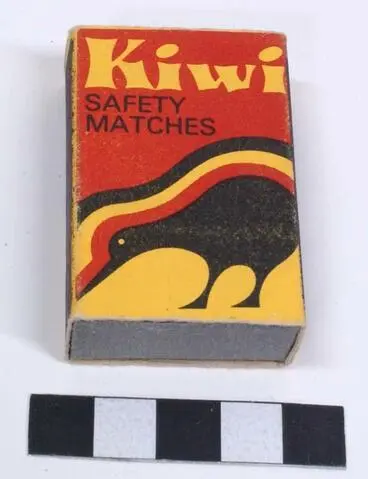
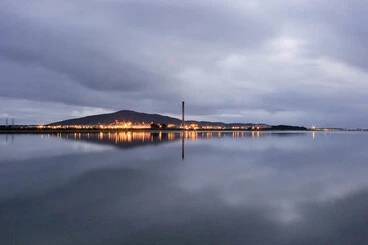


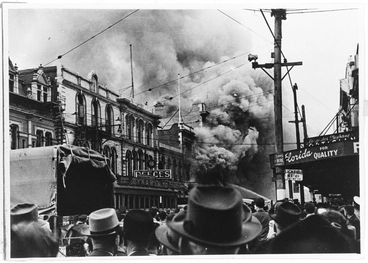

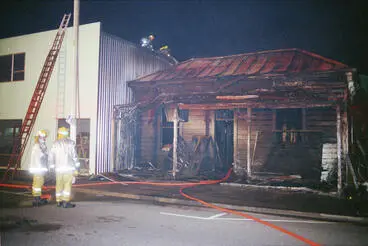
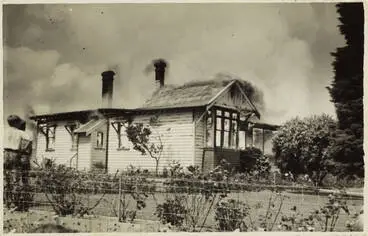
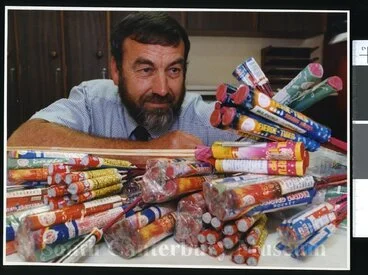
![William H. Hazard, gunmaker... Auckland, sole New Zealand agent for Pain's Imperial London fireworks. [List of fireworks]. Remember Guy Fawkes' Day, Saturday November 5th, 1910. Image: William H. Hazard, gunmaker... Auckland, sole New Zealand agent for Pain's Imperial London fireworks. [List of fireworks]. Remember Guy Fawkes' Day, Saturday November 5th, 1910.](https://thumbnailer.digitalnz.org/?resize=770x&src=https%3A%2F%2Flive.staticflickr.com%2F770%2F20739345762_f64fc43f3a_z.jpg&resize=368%253E)
